The saying goes, “you are what you eat,” and it’s true, particularly if you’re raising backyard chickens for food. What you feed them matters, but do you really know what’s in your chicken’s feed? And is grain even necessary in their diet?
Grain is a popular and common feed for chickens, but it’s hard to ensure the quality of grain and what additives might be in there.
How can you raise chickens without grain? Chicken keepers can maintain a well-rounded diet by replacing grain with other feeding methods and sources of nutrition, such as:
- Alternative Protein sources
- Sprouted grains and seeds
- Fermented grains and seeds
- Leftover food and kitchen scraps
- Vegetables
- Greens
- Fruits and nuts
- Compost
- Vermicompost (worms)
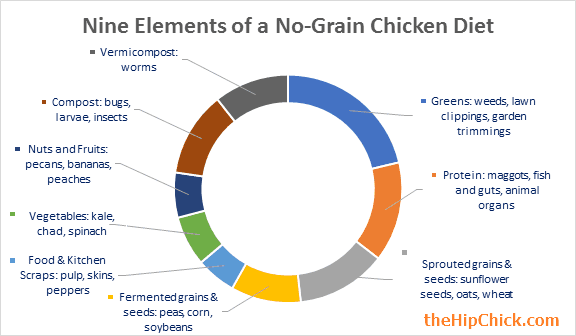
Backyard chickens have less than 350 taste buds much less than humans who have 10,000! However, chickens are very clear about what they prefer to eat. They go for protein first (bugs and worms), then grains, greens, and fruits, in that order.
Table of Contents
9 Great Ways to Raise Chickens Without Grain
There are nine categories every chicken keeper should address to ensure their birds get what they if opting for a no-grain diet. Let’s look at each one, how you can substitute for commercial grains, how to compost, and what not to feed your birds.
First, let’s dive into the nine elements of raising grain-free chickens. Many of these suggestions are being used by homesteaders who say they result in well-nourished chickens.
1. The Green Side of a Chicken’s Diet
Food for backyard chickens occurs naturally around your home. Chickens can find healthy food anywhere there is grass, weeds, and even in your garden.
Comfrey: This is considered an invasive weed, but the problem can actually be a solution if it’s used to feed your chickens. It’s also fed to cattle, sheep, pigs, horses, and goats. Not only is it edible, but it:
- Has medicinal properties
- Is high in protein
- Is a great source of nitrogen for compost piles
- Has vitamins and minerals
Comfrey contains high levels of vitamins B12 and A (for richer yolks), other vitamins like B and C, potassium, sulfur, calcium, iron, selenium, germanium, fiber, and phosphorus.
Stinging Nettle: Another invasive weed, nettles are like comfrey because the plant is edible and medicinal, and when dried contains protein and nitrogen for mulching and compost.
Weeds: Dandelion, burdock, yellow dock, and lamb’s quarter are other types of weeds that are good for chickens and have medicinal properties.
Grass and lawn clippings: Yard clippings from a mowed lawn can feed your chickens as well. In fact, fresh grass can substitute 15 to 20 percent of a chicken’s entire diet (though some say you can even get closer to 30 percent).
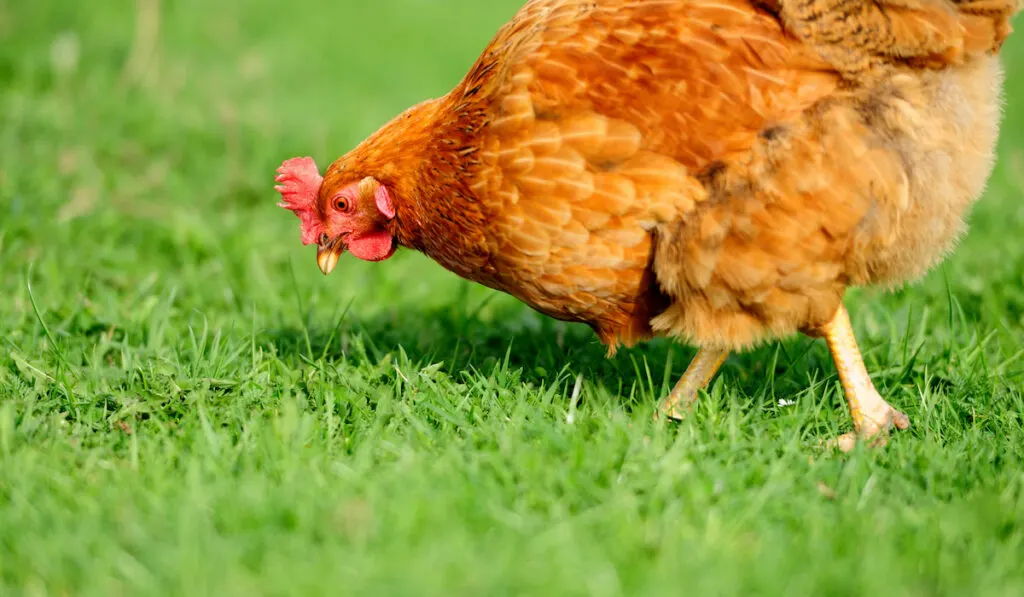
Garden leftovers: Weeds from your vegetable garden can be used as chicken feed. Also, any fruits or vegetables that you don’t like (but that are still edible) can be used for your flock. Chickens will eat most vegetables and fruits from your garden.
2. Sources of Protein for Chickens on No-Grain Diets
You need to feed high quality sources of protein to your chickens. After all, eggs are high in protein! Here’s where you can find proteins for your flock.
Animal carcasses: Be sure to cut the carcass open so chickens can access the insides, which is where the good stuff is. However, the remains should be removed after a couple of days to prevent disease. Be sure to use fresh carcasses to avoid limberneck disease (that’s botulism for birds).
Maggots: As well as the carcass, you can feed your chickens the worms that live in it. Maggots are packed with even more protein than the actual animal carcass!
Earthworms: Your birds probably already find these on their own (if they’re free-range), but you can still feed them worms yourself as an excellent source of protein.
Vermicomposting: You can also use worms to create compost and get two for one – protein for chickens in the compost they eat. We will talk more about compost later too.
Fish and fish guts: Another source of protein! If you fish as a hobby, this is a great way to use fish guts.
Animal entrails and organs: Animal organs are a great source of proteins. If you go hunting instead of fishing, or do both, this is an inexpensive way to feed your chickens, but again, be sure the organs are fresh!
Dehydrated Eggs: If you dehydrate your eggs, you can feed them to your chickens. You can also grind up eggshells and feed them to chickens, which is an excellent source of calcium. You’ll still have to feed them other sources of calcium, including oyster shells, but eggshells are a good supplement.
Legume seeds: These are as good for backyard chickens as they are for us. However, don’t feed them dried or feed raw beans, as these can be toxic.
Garden pests: Japanese beetles, slugs, bugs, and other small critters can be used as a natural protein source. If you allow chickens a limited time in the garden in the evenings, for example, they can graze and help debug your garden. Another two for one deal! Your chickens may nibble some of your produce but they will work wonders for bug problems.
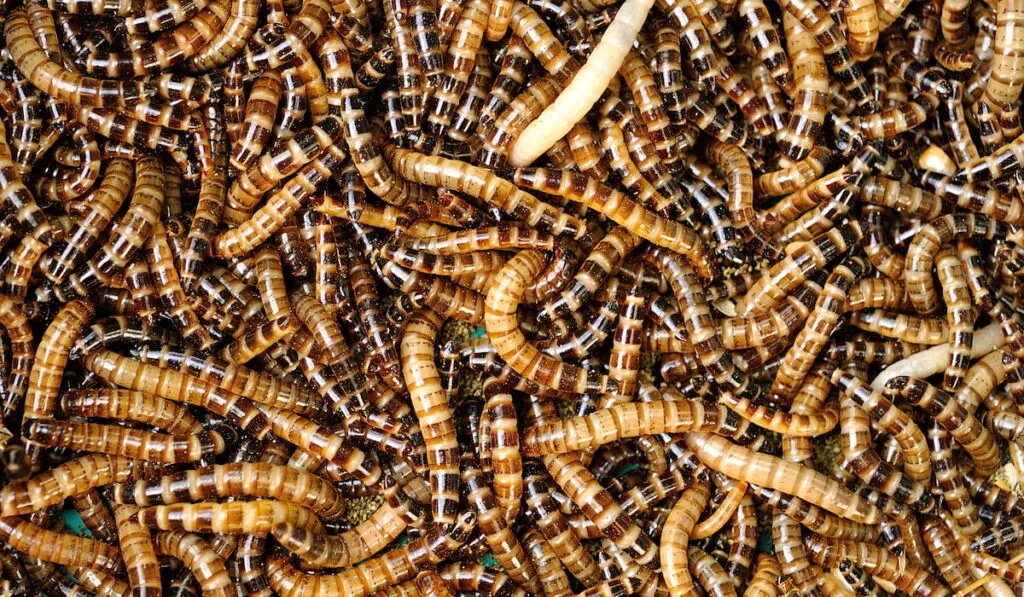
Protein supplements: Protein is an essential part of a chicken’s diet, so look for high-quality protein-rich nutrients. If you need to add more protein, you can supplement by adding different kinds of “meal” to your homemade feed. These include:
| Mealworms | Easily grown in your home, just place the larvae in oats, or with a carrot or potato. You can also purchase them online or at your local pet store. |
| Cottonseed meal | After the cotton is processed and the oil extracted from the seed, what is left can be used as meal. You can buy cottonseed and make the meal, but use this in moderation, as too much is toxic to chickens. |
| Camelina meal | This is high in omega-3s and is expensive, but it’s great nutrition for birds and a good protein substitute. |
| Flaxseed meal | Along with protein, this adds fiber and healthy fats to your chicken’s diet. You can buy flaxseed and grind it up, or purchase flaxseed meal. |
| Safflower meal | Once the plant oil is extracted, the fine powder that’s left is the meal. You can also buy the seeds or plant the flowers in your garden – chickens love the seeds and flowers! |
| Sesame seed meal | Interestingly, part of the process of getting this meal is cooking the sesame seed oil, and it’s great for your chickens too. |
| Peanut meal | Although high in protein, this choice isn’t not recommended for families with a peanut allergy. Science hasn’t yet concluded if it can be passed from chicken to egg, but it’s best to be on the safe side. |
3. Sprouting, Fodder, and Seeds for Your No-Grain Flock
Fodder is the soaking and sprouting of seeds that can be done at home, versus buying it in stores. Sprouting releases nutrients and proteins that are in seeds and dry grains. This makes it more digestible by up to 30 percent, and fodder is nutrient-dense and packed with proteins, vitamins, minerals, and enzymes.
There are a variety of seeds and grains that can be sprouted, including:
- Soybeans
- Oats
- Peas
- Corn
- Sunflower seeds
- Wheatgrass
- Wheat
You can buy a fodder system or use a bucket or bowl method. Depending on how much you want, sprouts can take anywhere from 4-7 days to grow. Here are two methods for sprouting seeds:
- Soak seeds for 24 hours in a bowl or bucket
- Strain seeds and thoroughly rinse
- Put seeds in another bucket or bowl
- Leave them for 24-hours – seeds sprout faster in warm temperatures
- Rinse seeds every 24 hours for the next 2-3 days
- Soak seeds in a container for 12-24 hours
- Place them in a container with holes in the bottom for drainage
- Water seeds daily for seven days
For a continual supply, use two containers and rotate them on different cycles. You can also soak seeds daily, so the fodder is on a seven-day cycle.
4. Fermented Seeds and Grains as Part of a Chicken’s Diet
If you don’t want to use the fodder system to sprout seeds, you can still buy seeds, and even buy feed and ferment it – fermenting feed makes it a more digestible, and more efficient feed. Wheat seeds are also a great choice, and can strengthen eggshell consistency in your eggs.
To ferment feed, soak it for a day, so it breaks down the antinutrients. Fermentation also releases vitamins B, K2, and enzymes.
Directions:
- Put 2-3 days’ worth of feed in a food-grade container
- Add enough water to cover two inches above feed
- After an hour, check to make sure at least one inch of water is left
- Cover loosely with a towel or lid
- Fermentation will be complete in three days (it will smell sour)
- If it gets moldy throw it out and start over
5. Add Food and Kitchen Scraps into the Chicken’s Diet
It’s not just the table scraps that your birds will eat! The pulp and seeds from fruits and vegetables can be used as chicken feed, and scraps of things like bell peppers and cantaloupes. However, some chicken farmers frown on leftover food because it can lead to weight problems in chickens if fed too often.
Nutritionist Patrick Biggs, Ph.D., offers the advice of treating kitchen scraps as special indulgences for your chickens. He says:
“Treats like scraps, scratch grains, and mealworms are like candy for birds, which can quickly spoil their diet. The best treats for chickens are natural, healthy, and wholesome.”
Biggs recommends a “90/10 chicken feed rule,” which suggests feeding treats in moderation – no more than 10 percent of their daily diet. The same goes for chicken scratch, if you still include it in your no-grain diet.
6. Grow a Chicken-Friendly Garden
If you have a garden, it’s not just the bugs and critters that chickens love, its what’s in your garden as well. They will usually go for the bugs first,but will also probably nibble your plants as well.
That means if you plant certain vegetables and fruits that aren’t good for them (and they happen to pluck at a few), they could get sick. If you plan to let your chickens into your garden to control your pests, you may need to fence off some of your plants to keep your hens safe.
The two for one pattern continues here too. Whatever produce you discard, chickens can enjoy that when you allow supervised garden roaming. It’s recommended that you wire-off your chicken-friendly garden, so roaming privileges are restricted. Start by feeding them before allowing them to walk the garden. That way, they’ll mainly seek out bugs and garden pests.
The list of healthy chicken snacks and treats is long, but dark leafy vegetables and legumes produce richer yolks. Chickens love green vegetables, and some vegetables can grow all year-round, even in winter, and are a great source of food for you and your chickens.
Here’s a list of what you can grow that will serve both your diet and your chickens’ – remember though that fruits are high in acids and sugars and should be fed in moderation:
| Lettuce | Ferns | Arrowroot | Chicory | Lavender | Orach |
| Kale | Squash | Bok Choy | Buckwheat | Mint | Sunflowers |
| Sunchokes | Pumpkins | Swiss Chard | Cocksfoot | Oregano | Daylilies |
| Chad | Cucumbers | Linseed | Lucerne | Parsley | Hostas |
| Beets | Plantain | Silverbeet | Amaranth | Cilantro | Daisies |
| Broccoli | Alfalfa | Peas | Sorghum | Thyme | Roses |
| Carrots | Lentils | Chickweed | Millet | Basil | Speen |
| Clover | Wineberries | Watermelon | Strawberries | Blueberries | Raspberries |
| Spinach | Turnip greens | Dandelion | Parsnips | Sorrel | Rye |
7. Fruits and Nuts in a Healthy Chicken Diet
Regardless of which side of the grain debate you fall on, all chickens love fruits and nuts and can eat them in moderation. They can also serve in place of grains as well as help enhance a well-balanced diet.
Wild seeds and fruits can substitute for store-bought grains and are another significant source of protein for chickens. The following nuts are not digestible whole by chickens, so a feed grinder should be used:
- Wild nuts
- Oaks
- Beeches
- Pecans
- Black Walnuts
- Hickories
If you have the room and climate to plant fruit trees, some easily-maintained ones are also good for chicken diets. They include:
- Persimmons
- Mulberries
- Paw-paw
- Apples (with seeds removed)
- Pears
- Peaches
- Bananas
8. Composting Is a Rich Source of Nutrients for Chickens
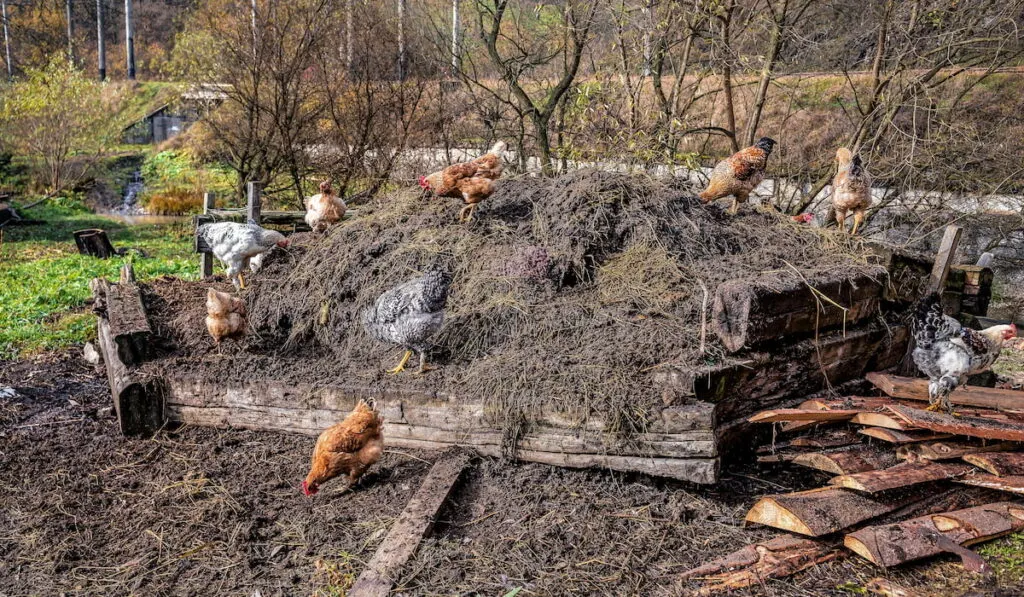
Another way to go grain-free is to compost, especially since commercial feed is often genetically modified, some feed is loaded with antibiotics, growth hormones, and synthetic formulas – all things that aren’t good for chickens or the eggs they produce. And, the organic feed brands that are worthwhile are costly.
Backyard homesteaders are turning to the methods of ancient farmers, who used composting. The biodegradable and micro-nutrient miles you get out of it far outweigh the efforts to build and sustain a compost. This method can easily save you money on chicken feed and is the easiest way to get your flock the nutrients they need.
In addition to your household food scraps, check your local health food store, school cafeterias, food pantries, farmer’s markets, and restaurants for their kitchen and garden scraps.
If you’re still on the fence about composting and unsure if it’s worth it, here are some of the benefits.
- Your flock is healthier
- Less disease and more robust immune systems
- Eggs are more nutrient-dense
- A food source that is easily accessible to chickens on-demand
- Nothing goes to waste
- Chicken dropping fertilizes the soil – great if you have a garden
- Microbes produced from compost piles are also great for gardens
- Birds will scratch and pick edibles (bugs, larvae, and insects) and turn and mix the compost as they go
- High protein and calcium-rich diet
Further, almost anything can go into your compost, including:
- Stale bread
- Old oats
- Fruit peels
- Scraps from the kitchen and garden
- Grass clippings
- Leaves, branches, and dead plants
- Manure and hay beds
- Lime – it is microbe-rich and provides calcium for laying hens
There are a few things to avoid putting in your compost of you plan to feed it to your chickens. Don’t add avocado skin and seed, citrus, garlic, onions, bones, and rotten meat scraps to compost (more on this later).
How Do I Set Up a Compost Pile?
Stack up the ingredients you collected (see above). Add enough water for moisture, but don’t saturate your compost pile however. Throw food and kitchen scraps on top of the pile each week, and add water to keep moisture levels up.
Then, just let it sit – the chickens will do the rest. It may take several months to a year to produce a good compost batch, but it’ll be worth it.
9. Vermicomposting for Chickens – in Just 13 Steps
This method is a process by which worms are used to create compost. Worms can be grown year-round and create a great source of protein. Here are the 12 steps to vermicomposting:
- Use a large wood or plastic bin. If it’s not already ventilated, drill holes in it.
- For every square foot, estimate one pound of worms.
- Cover the bin to keep out light (worms hate light) and regulate the moisture.
- Place the bin in a cool, shaded area (between 30-70 degrees Fahrenheit).
- Always keep at least four inches of moist material in the bin.
- Next, put in “bedding” such as shredded cardboard, paper, or straw and sprinkle with dirt.
- Add moisture, but not too much – it should just be moist, not wet.
- Put worms in, such as Red Wrigglers, which can be purchased online.
- Add food scraps at least once a week. Be careful about adding citrus, meat, and dairy; they will be difficult to break down.
- If the bin smell too much, add fewer materials – the worms will catch up soon enough!
- In 3 to 6 months, it will be time to harvest the worms and compost.
- Scrape new material out of the way and dig out the compost.
- Sift out the worms and feed it to the chickens.
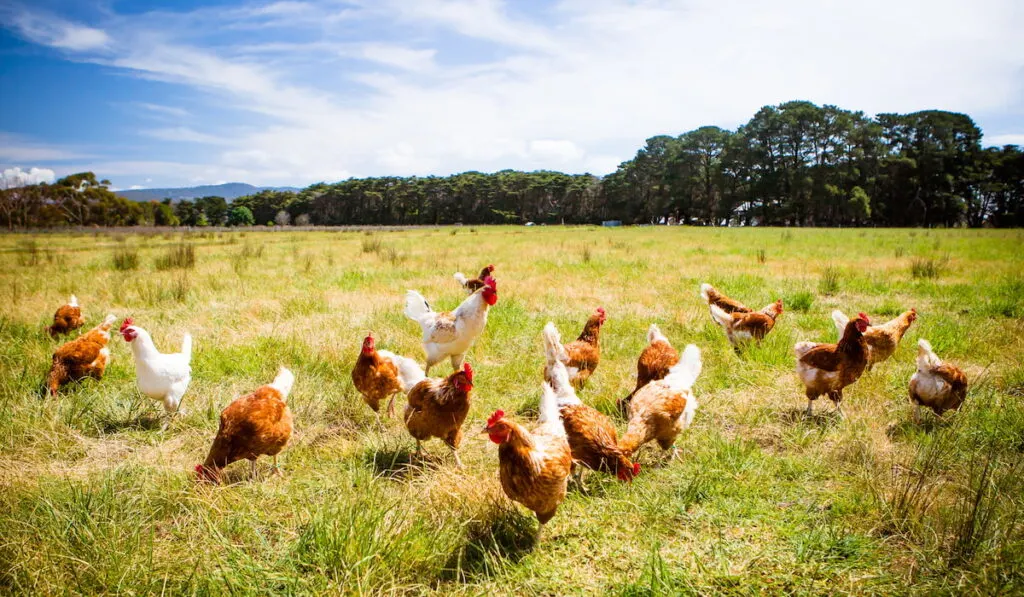
Does a No-grain Diet Really Work for Chickens?
According to Nutritionist Patrick Biggs, Ph.D., chickens require 38 unique nutrients at the correct levels, so commercial feeds are popular for many chicken farmers. “To prevent nutrient dilution, provide a complete feed for at least 90-percent of the bird’s diet. The remaining 10-percent can be filled with chicken treats, table scraps, or scratch grains,” he says.
However, there are many benefits to not feeding backyard chickens grains. But how can you tell if you are getting the diet right for your grain-free chickens? For example, if you remove grain from their diet, would feeding dark leafy greens still result in darker, richer yolks, and how would you know for sure?
According to an article in Garden Culture Magazine, one Vermont farmer tested that out. In 1998, Karl Hammond began feeding his flock of 600-plus free-range birds “fresh compost piles 365 days a year” in a “no-grain/recycling system.” Newly hatched chicks were the only ones fed any grain (with mash) for a few days.
“The question of just how much grain do chickens actually need … was zero-percent of their daily diet,” the magazine reported. The compost pile consisted of “part food scraps, part horse or cow manure, and part bad hay,” along with restaurant composting waste. In a 2017 YouTube interview, Hammond explained as much.
“The truth is that you don’t have to feed chickens grain, and they will be healthier … Chickens raised in this manner don’t need drugs or vaccinations to remain disease-free.” Garden Culture Magazine
What Are Some Ways to Raise Chickens Without Grain?
Feeding chickens without grains can be beneficial if you follow the right dietary requirements to keep them healthy. Like us, they need proteins, carbohydrates, vitamins, supplements, minerals, and fiber.
Typical Nutritional Table for Different Types of Poultry
An article from the University of Georgia Extension discusses “the right diet for the right bird.” This is based on the type of bird, for example, a broiler (meat bird), pullet (young hen), or an egg-laying hen, as well as their age, For different types and ages of chickens, dietary needs change.
Essentially:
- Meat birds need 18-22% protein, less than 1% calcium, 5-6% fat and 2.5% fiber
- Young hens need 17-20% protein, about 1% calcium, 4% fat and 3% fiber
- Egg-laying hens need 16-18% protein, 3.5-4.5% calcium, 4% fat and 3-4% fiber
Giving birds the wrong type of feed can – in extreme cases – result in illness or death. It is important to determine what kind of birds you are raising, how old they are, and what their specific needs are, then make sure your diet is right for your chickens.
What Not to Feed Your Chickens
There is an extensive list of foods that are safe to feed your chickens. However, regardless of what you choose to include in their diets or what stage of life they’re in (chick or pullet), their nutrition should never include certain things.
The following foods should be avoided when dealing with your backyard flock:
| Uncooked rice | Cooked rice is okay, but when it’s dry, it will swell and cause serious digestive issues in chickens. |
| Raw Eggs | Chickens who eat raw eggs may turn into cannibals. |
| Salty Foods | Too much salt can cause hypernatremia in chickens |
| Onions | They have thiosulphate, which destroys red blood cells, causing anemia and jaundice when chickens overeat it. It may be tolerable in small quantities. |
| Citrus fruits | Certain types of chickens are sensitive to it because it contains citric acid. |
| Green Potatoes | Any part of green potato peels, sprouts, and flesh, has toxins (Solanin and chaconine) and is poisonous to chickens. Cooked potatoes may be OK, but they don’t contain much nutrition. |
| Tomatoes | Solanin and chaconine are also found in unripened green tomatoes. Once ripe, fewer toxins are present, but some chicken keepers prefer to avoid tomatoes altogether. |
| Chocolate | Caffeine and theobromine are toxins found in chocolate. If enough is digested, heart problems, including irregular heartbeat and heart attacks will occur in chickens. Candy and sugars are all best avoided. |
| Dried or raw beans | all dried beans are dangerous, especially kidney beans – they contain a toxin caked hemagglutinin, which is fatal and can kill a chicken after eating just three of four beans. Cooked beans are fine for chickens. |
| Avocado | The skin or pit of an avocado has a toxin called persin, which in large doses, can cause heart problems and difficulty breathing. At that point, death comes quickly. The bark and leaves of the tree are dangerous, too, but the flesh seems to be safe, but you may prefer to avoid avocados completely. |
| Moldy foods | Foods that are either spoiling, moldy, damp, rotten, or rotting should be avoided. The mold can develop toxins that are harmful to chickens. It’s best to stay away from any foods showing even early signs of mold or spoiling. |
| Nightshades | Rhubarb leaves contain anthraquinones, which acts as a laxative, and when exposed to severe cold, the oxalic acid levels increase and can be fatal to chickens. Nightshades, in general, contain this toxin and can cause kidney failure in chickens. |
| Apple seeds | If you feed apples, remove the seeds as they contain cyanide and will kill chickens. |
| Flowering plants | Lupines cause nervous system failure and death; foxglove has digitalis, which causes the heart to slow down; and holly causes vomiting and acts as a laxative. |
| Seasonings | Chives and garlic can be eaten in small quantities, but otherwise, it’s harmful to chickens because they cause a serious blood condition. |
Grain-Free FAQs
If I go the grain-free route, do I still need chicken scratch? Chicken scratch or scratch grains are what many homesteaders call junk food. It will not hurt them if used in moderation but should be considered a treat. It’s a great way to encourage foraging, but it is not part of a balanced meal, so it’s up to you to decide if you want to use it.
If I use grain or chicken scratch for my chickens, how much should I give them? Chicken scratch should only be 10 percent of their diet, which works out to be about 2 teaspoons per chicken for one serving. Overall, chicken scratch contains 8 percent protein.
What can I use instead if I put chickens on a grain-free diet? Kitchen scraps and vegetable pulp can be substituted for chicken scratch. You can even add worms as chickens need more high protein food.
